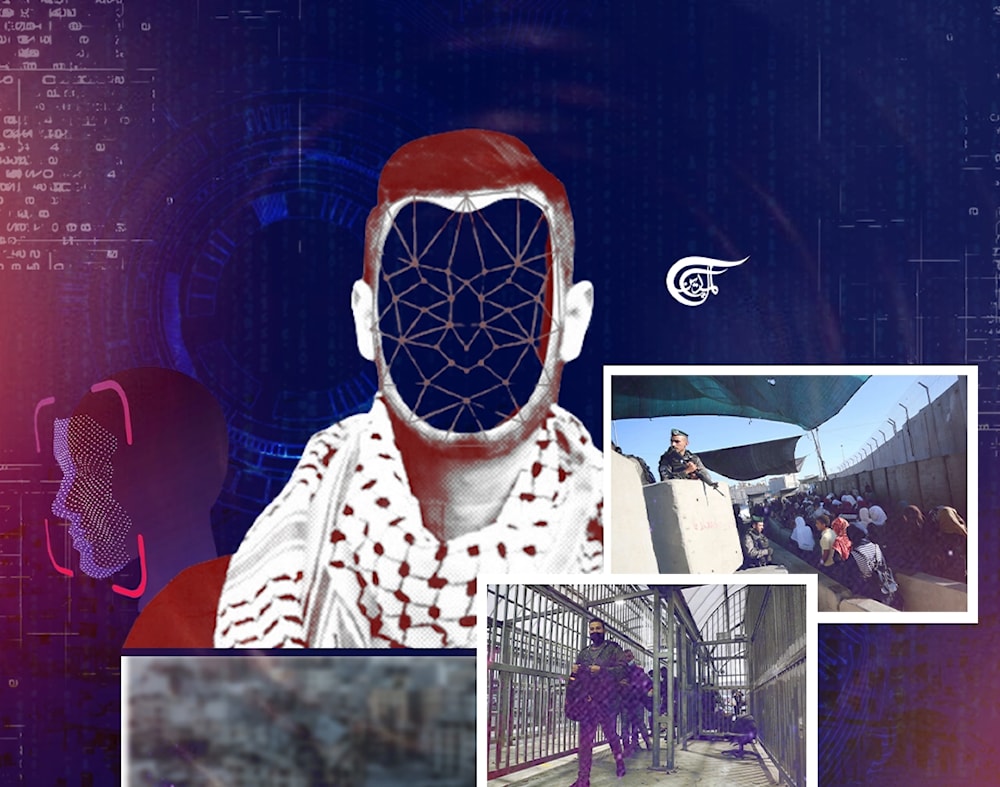The Israeli tech war on Palestine
The Israeli war on Palestine is making the most of new AI-powered, surveillance, and defense technologies.
-

In the West Bank, Palestinians must pass through checkpoints where Red Wolf scans their faces and tells IOF soldiers whether they should pass, be interrogated, or detained. (Al Mayadeen English; Illustrated by Batoul Chamas)
The Israelis are pummeling Gaza — with the assistance of the very latest in AI-powered, surveillance, and defense tech.
For starters, the Israeli government is using an AI-powered system, which it calls "habsora" ("the Gospel") to rapidly identify targets in Gaza to bomb. In fact, with the assistance of tools like the Gospel system, the IOF has struck 22,000 targets in the Gaza Strip as of 15 December, often striking hundreds of targets per day.
In a pre-war interview, former Israeli Occupation Forces (IOF) Chief of General Staff Aviv Kochavi described the Gospel system as "a machine that produces vast amounts of data more effectively than any human, and translates it into targets for attack." Indeed, the Gospel system can allegedly identify 100 attack targets per day, much faster than the IOF’s estimated 50-100 targets that an intelligence team could previously select in about 300 days.
Meanwhile, other defense-oriented, AI-powered tech groups are assisting Gaza’s destruction. Prominent US-based drone manufacturer Skydio has been sending the IOF reconnaissance drones, and defense and aerospace startup Shield AI is providing the Israelis with Nova 2 self-piloting drones, suited for close range and even indoor combat. The Israelis also reportedly requested 200 Switchblade 600 kamikaze drones after October 7.
Israeli forces say that AI-powered tools like the Gospel can save lives, claiming their purported accuracy ensures civilians are less likely to be hit. But such assertions cannot be taken at face value within the context of the Israeli mass destruction of Gaza, where Israeli leaders and institutions actively call for ethnic cleansing, and Israeli forces frequently attack civilian-dense hospitals and schools. As Jonathan Ofir reported for Mondoweiss in October, for example, the Misgav Institute for National Security & Zionist Strategy, an Israeli think tank, advocated for a "relocation and final settlement of the entire Gaza population" and to "evacuate the whole Gaza strip."
David Azoulai, the head of the Israeli "Metulla" Council, even said in a radio interview that "the entire Gaza Strip should be emptied and leveled flat, just like in Auschwitz… Let it become a museum, showcasing the capabilities of the State of Israel and dissuading anyone from living in the Gaza Strip."
Zooming out, the UN estimates that almost 1.5 million Palestinians have been internally displaced since October 7, with over 60 percent of the Gaza Strip’s housing units destroyed as of early December. In fact, almost 20,000 people have been killed in Gaza at the time of writing. The ongoing carnage includes a campaign against Gaza-based journalists and writers, which has led to the deaths of 97 journalists as of December 19. The Israelis have also targeted activists and intellectuals, including prominent writer Dr. Refaat Alareer, who was recently killed in an "apparently deliberate" Israeli air strike.
And while the bombs drop, the Israelis are upping their surveillance capacities in Palestine, likely using the controversial Israeli spyware company NSO Group's Pegasus, a spyware able to infiltrate a person’s device without their knowledge. While NSO Group claims Pegasus is helping track the status of Hamas-held captives, cybersecurity experts and rights activists, skeptical that Pegasus is suited for such a task, ponder whether such claims are about rehabilitating NSO Group’s tarnished reputation (NSO Group is on a US blacklist.) Citing the alleged use of Pegasus to spy on journalists as early as 2020, rather, Axios cybersecurity reporter Sam Sabin explains there are seemingly few controls in place to "ensure [Pegasus] technology won't be used for broad surveillance of the entire Palestinian population."
Meanwhile, the Israeli government has entrenched an extensive surveillance framework in the West Bank, including facial-recognition cameras, manned checkpoints, watch towers, and the mass (and often biometric) data collection of Palestinians’ information via the "Wolf Pack" system, which has a profile of "virtually" every Palestinian living in the West Bank.
In West Bank’s Hebron (Al-Khalil), Palestinians going about day-to-day life must pass through checkpoints which scan their faces, where "Red Wolf" software, according to Middle East Eye, "uses a colour-coded system to tell Israeli soldiers whether Palestinians should pass, be interrogated or detained." (Middle East Eye also reports that Israeli settlers in Hebron do not have to pass through the checkpoints). "Blue Wolf," meanwhile, a pared-down version of Wolf Pack suitable for smartphones, allows Israeli soldiers to compare the photo they take of a Palestinian person with a larger database of photos to allow or deny them entry through a given checkpoint.
Through this multi-faceted framework, the Israelis have effectively "locked" Palestinians living in the West Bank in their neighborhoods for days at a time since October 7. Namely, West Bank residents told Wired contributor Tom Bennett they’re able to leave their neighborhood "just three days per week."
Ultimately, state-of-the-art AI, surveillance systems, and other adjacent weapons technologies are being deployed widely and thus normalized in wartime, bypassing critical ethics conversations as to how or whether they should be used. Meanwhile in Palestine, the Israelis have equipped such tools to destroy infrastructure, surveil, and kill en masse.

 Stavroula Pabst
Stavroula Pabst
 5 Min Read
5 Min Read










